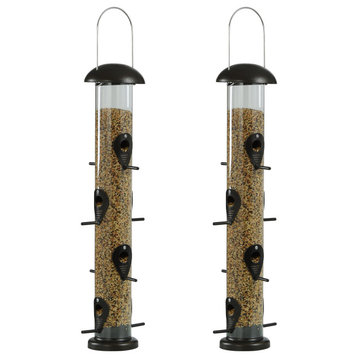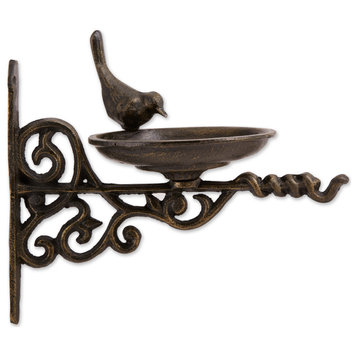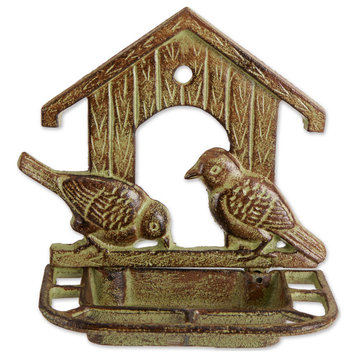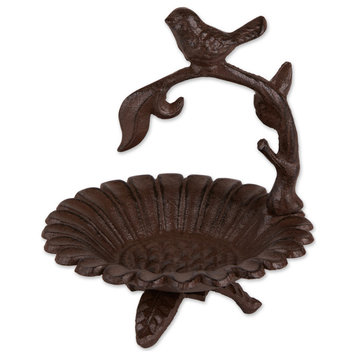FREE shipping on orders over $49!* Details
- All Products
- Outdoor
- Outdoor Decor
- Bird Feeders
Bird Feeders
4 Results
Sort by:
Price
4 Results

Set of Two Large Bird Feeders Brown Powder Coatedby StyleCraft
$60
Free Shipping
Invite nature into your space by placing this beautiful bird feeder outside an open window, nearby a patio, or in your garden. This feeder comes as a set of two with eight feeding ports on each piece. It is made from metal and finished in dark bronze giving it a sturdy sleek design perfect for your home.
Features -
- Due to the production process, each piece is unique and no two are exactly alike.
- This feeder is sure to attract an array of wild life into your outdoor space giving you a glimpse into all that nature has to offer.
- This feeder has eight feeding ports and arrives as a set of two. It is made from metal and finished in a stunning dark bronze.
Specifications -
- Location Rating - Damp

Wall Mounted Ornate Cast Iron Bird Feederby EL: STORAGE
$46
Free Shipping
WALL MOUNTED ORNATE CAST IRON BIRD FEEDERDII offers full collections of trend based designs, bringing you fresh, innovative lines of quality home and garden products for every season. Let DII products become a valuable part of your life.
- CAST IRON DCOR FOR YOUR HOME: Cast Iron wall hook weighs 4.3 lbs. and measures 11.25x6x9.9 inches
- DURABLE AND LONG LASTING: Made of durable cast iron to create a durable and decorative garden pathway
- EASY CARE: To clean, simply dust lightly or wipe with a damp cloth
- MAKES A FUN GIFT: This cast iron dcor is a fun piece that will be a favorite for years to come, also a great gift to give for that special someone

Wall Mounted Cast Iron Bird Feederby EL: STORAGE
$44
Free Shipping
WALL MOUNTED CAST IRON BIRD FEEDERDII offers full collections of trend based designs, bringing you fresh, innovative lines of quality home and garden products for every season. Let DII products become a valuable part of your life.
- CAST IRON DCOR FOR YOUR HOME: Cast Iron wall hook weighs just under 3.4 lbs. and measures 8.5x4.4x8.5 inches
- DURABLE AND LONG LASTING: Made of durable cast iron to create a durable and decorative garden pathway
- EASY CARE: To clean, simply dust lightly or wipe with a damp cloth
- MAKES A FUN GIFT: This cast iron dcor is a fun piece that will be a favorite for years to come, also a great gift to give for that special someone

Sunflower Cast Iron Bird Feederby EL: STORAGE
$44
Free Shipping
SUNFLOWER CAST IRON BIRD FEEDERDII offers full collections of trend based designs, bringing you fresh, innovative lines of quality home and garden products for every season. Let DII products become a valuable part of your life.
- CAST IRON DCOR FOR YOUR HOME: Cast Iron wall hook weighs just over 3 lbs. and measures 7x7x8.3 inches
- DURABLE AND LONG LASTING: Made of durable cast iron to create a durable and decorative garden pathway
- EASY CARE: To clean, simply dust lightly or wipe with a damp cloth
- MAKES A FUN GIFT: This cast iron dcor is a fun piece that will be a favorite for years to come, also a great gift to give for that special someone
Adding a bird feeder or two to your outdoor area is an easy and fun way to interact with nature. You may want to grab an identification book along with your purchase to help you identify all of the colorful species you’ll attract. Bird feeders come in a variety of styles and look great hanging from a porch entry or tree. Bird tables also get bonus points for inviting avian friends into your garden to get rid of pests. While you’re searching for a new feeder, here are a few tips to keep your feathered friends happily feasting:
There are a few types available, and which one you choose depends on your preferences as well as what types of birds you’d like to attract. Here’s a quick roundup of the most common styles:
• Bird tables: These open seed dispensers attract a wide variety of seed-eating birds, most notably pigeons, starlings, grosbeaks and sparrows, plus chipmunks and squirrels. They aren’t protected from the weather, so be sure yours allows water to drain so seeds don’t begin to sprout. You’ll also want to wash it frequently and be sure to shake out any old seeds when you refill the tray. They’re extremely versatile and can be mounted on a post, suspended or installed on a deck railing.
• Suet: Designed to hold a block of suet within a wire mesh enclosure, suet feeders are a favorite spot for woodpeckers, nuthatches, jays, starlings, chickadees and titmice. This style can be attached to a tree trunk or suspended from a porch roof.
• Hoppers: This style holds a large amount of seed and is a favorite of finches, jays, cardinals, sparrows, grosbeaks, titmice, buntings, chickadees and, yes, squirrels. It offers some protection against droppings and inclement weather, but it’s still possible for the inside of the hopper to get wet. Be sure to clean yours out to prevent fungus and bacteria from growing. Hoppers can be mounted on a post or suspended from a pole, and if you prefer to keep those nutty squirrels away, you can also invest in a squirrel baffle.
• Tubes: A tube dispenser does a great job of keeping bird seed dry and clean. It’s a popular attraction for grosbeaks, finches, sparrows, chickadees and titmice. Depending on the size of your ports, you may also be able to leave out nyjer seed, which is a favorite of pine siskins, common redpolls and American goldfinches. Designs with metal feeding ports tend to be more squirrelproof than those with plastic ports, and it’s a good idea to block off the bottom of the tube if yours extends below the bottommost port.
• Hummingbird feeders: Specially designed for our tiniest feathered friend, these offer up nectar instead of seed. They require regular cleaning, but it’s well worth a glimpse of a hummingbird as it hovers for a snack.
• Squirrel feeders: With squirrels’ zany antics and comical poses, sometimes it’s best and more fun to give in to them. Many feeders intended for our furry woodland friends feature a place to attach a corncob or place a hopper for seeds. It’s also a good idea to clean these every so often, especially if you have a hopper-style feeder.
Bird feeders should always be placed in a quiet place where they’re easy to see and refill. It’s actually best to place them closer than 3 feet to any large windows to reduce the chance that birds might injure themselves if they fly into your window. When the seed is placed farther away, it gives birds time to accelerate their speed, which causes them to hit the glass much harder. A location near trees or other coverage can also be ideal, but be wary of branches that are too close, as these can provide a great access point for squirrels or even a hungry feline.
Hummingbird feeders are best placed in a shaded location with protection from the wind. You want to avoid having them sway and spill nectar, not to mention that sugar solutions spoil much faster in the sun.
Successfully attracting birds to eat from your feeders requires consideration on multiple levels. First, you’ll want to research what species frequent where you live and make sure you purchase a style that will appeal to them. Once you’ve selected a style that’s suitable, place it in a protected area and away from the reach of squirrels or other outdoor creatures to ensure that birds feel comfortable visiting. Make sure you keep your bird table or hummingbird feeder clean and provide appropriate food. If it’s been a few days and still no birds come to enjoy a treat, be patient. You can also try sprinkling seeds on the ground nearby or look into adding some bird-friendly plants.
What types of bird feeders can I add to my backyard?
There are a few types available, and which one you choose depends on your preferences as well as what types of birds you’d like to attract. Here’s a quick roundup of the most common styles:
• Bird tables: These open seed dispensers attract a wide variety of seed-eating birds, most notably pigeons, starlings, grosbeaks and sparrows, plus chipmunks and squirrels. They aren’t protected from the weather, so be sure yours allows water to drain so seeds don’t begin to sprout. You’ll also want to wash it frequently and be sure to shake out any old seeds when you refill the tray. They’re extremely versatile and can be mounted on a post, suspended or installed on a deck railing.
• Suet: Designed to hold a block of suet within a wire mesh enclosure, suet feeders are a favorite spot for woodpeckers, nuthatches, jays, starlings, chickadees and titmice. This style can be attached to a tree trunk or suspended from a porch roof.
• Hoppers: This style holds a large amount of seed and is a favorite of finches, jays, cardinals, sparrows, grosbeaks, titmice, buntings, chickadees and, yes, squirrels. It offers some protection against droppings and inclement weather, but it’s still possible for the inside of the hopper to get wet. Be sure to clean yours out to prevent fungus and bacteria from growing. Hoppers can be mounted on a post or suspended from a pole, and if you prefer to keep those nutty squirrels away, you can also invest in a squirrel baffle.
• Tubes: A tube dispenser does a great job of keeping bird seed dry and clean. It’s a popular attraction for grosbeaks, finches, sparrows, chickadees and titmice. Depending on the size of your ports, you may also be able to leave out nyjer seed, which is a favorite of pine siskins, common redpolls and American goldfinches. Designs with metal feeding ports tend to be more squirrelproof than those with plastic ports, and it’s a good idea to block off the bottom of the tube if yours extends below the bottommost port.
• Hummingbird feeders: Specially designed for our tiniest feathered friend, these offer up nectar instead of seed. They require regular cleaning, but it’s well worth a glimpse of a hummingbird as it hovers for a snack.
• Squirrel feeders: With squirrels’ zany antics and comical poses, sometimes it’s best and more fun to give in to them. Many feeders intended for our furry woodland friends feature a place to attach a corncob or place a hopper for seeds. It’s also a good idea to clean these every so often, especially if you have a hopper-style feeder.
Where should I place my bird feeder?
Bird feeders should always be placed in a quiet place where they’re easy to see and refill. It’s actually best to place them closer than 3 feet to any large windows to reduce the chance that birds might injure themselves if they fly into your window. When the seed is placed farther away, it gives birds time to accelerate their speed, which causes them to hit the glass much harder. A location near trees or other coverage can also be ideal, but be wary of branches that are too close, as these can provide a great access point for squirrels or even a hungry feline.
Hummingbird feeders are best placed in a shaded location with protection from the wind. You want to avoid having them sway and spill nectar, not to mention that sugar solutions spoil much faster in the sun.
How can I attract birds to my bird table?
Successfully attracting birds to eat from your feeders requires consideration on multiple levels. First, you’ll want to research what species frequent where you live and make sure you purchase a style that will appeal to them. Once you’ve selected a style that’s suitable, place it in a protected area and away from the reach of squirrels or other outdoor creatures to ensure that birds feel comfortable visiting. Make sure you keep your bird table or hummingbird feeder clean and provide appropriate food. If it’s been a few days and still no birds come to enjoy a treat, be patient. You can also try sprinkling seeds on the ground nearby or look into adding some bird-friendly plants.






